Investigating the role of ELK3 transcription factor in the migration of triple negative breast cancer cells, using genomic and microfluidic approaches
Postdoctoral Research Project
About the project
Project title: Investigating the role of ELK3 transcription factor in the migration of triple negative breast cancer cells, using genomic and microfluidic approaches
Acronym: GENOMICROELK
Project Type: Postdoctoral research project
Project ID: PN-III-P1-1.1-PD-2021-0525
Contract No: PD62/2022
Contracting unit: UEFISCDI
Total budget: 249.960 Lei (aprox. 51.200 €)
Project duration: 24 months (01/04/2022 - 31/03/2024)
Project summery
Metastasis is the main cause of breast cancer (BC)-related death, no therapies that target this process being available. Therefore, there is a need to elucidate the molecular mechanisms that govern metastasis in order to develop therapeutic strategies that are able to target the metastatic cells. The ELK3 transcription factor is a molecule whose expression we found to be correlated with the migration capacity of BC cells, and thus it might be a key regulator of cancer metastasis. In this context, the goal of this project is to evaluate the role of ELK3 in BC metastasis, by studying its involvement in cell migration, epithelial-to-mesenchymal transition and the cancer stem cell phenotype, and some of the underlying molecular mechanisms. BC cell lines in which ELK3 is either overexpressed (ELK3-OE) or knocked-down (ELK3-KD) will be generated by a lentiviral cell transduction procedure. The transformed cells will be evaluated in terms of their cell migration capacity in 3D microfluidic devices, EMT phenotype by flow-cytometry and stemness potential in mammosphere formation assays. On the other hand, in a functional genomic approach (microarray technology), the molecular effects triggered by both ELK3-OE and ELK3-KD will be assessed by identifying the gene expression patterns that are modulated in these transformed cells. The results regarding the cellular effects will be confronted with the molecular changes triggered by the overexpression/knockdown of ELK3, emphasizing the molecular mechanisms by which ELK3 might affect BC metastasis.
Acronym: GENOMICROELK
Project Type: Postdoctoral research project
Project ID: PN-III-P1-1.1-PD-2021-0525
Contract No: PD62/2022
Contracting unit: UEFISCDI
Total budget: 249.960 Lei (aprox. 51.200 €)
Project duration: 24 months (01/04/2022 - 31/03/2024)
Project summery
Metastasis is the main cause of breast cancer (BC)-related death, no therapies that target this process being available. Therefore, there is a need to elucidate the molecular mechanisms that govern metastasis in order to develop therapeutic strategies that are able to target the metastatic cells. The ELK3 transcription factor is a molecule whose expression we found to be correlated with the migration capacity of BC cells, and thus it might be a key regulator of cancer metastasis. In this context, the goal of this project is to evaluate the role of ELK3 in BC metastasis, by studying its involvement in cell migration, epithelial-to-mesenchymal transition and the cancer stem cell phenotype, and some of the underlying molecular mechanisms. BC cell lines in which ELK3 is either overexpressed (ELK3-OE) or knocked-down (ELK3-KD) will be generated by a lentiviral cell transduction procedure. The transformed cells will be evaluated in terms of their cell migration capacity in 3D microfluidic devices, EMT phenotype by flow-cytometry and stemness potential in mammosphere formation assays. On the other hand, in a functional genomic approach (microarray technology), the molecular effects triggered by both ELK3-OE and ELK3-KD will be assessed by identifying the gene expression patterns that are modulated in these transformed cells. The results regarding the cellular effects will be confronted with the molecular changes triggered by the overexpression/knockdown of ELK3, emphasizing the molecular mechanisms by which ELK3 might affect BC metastasis.
Objectives
The overall goal of this project is to elucidate the impact of the transcription factor ELK3 in the metastasis of triple negative breast cancer, in an attempt to nominate this molecule as a molecular target for future therapeutic strategies in breast cancer.
Specific objective 1. Generation of genetically modified triple negative breast cancer cell lines with stable overexpression (ELK3-OE) or stable inhibition (ELK3-KD) of the ELK3 transcription factor, by lentiviral transduction.
Specific objective 2. Evaluation of the cellular effects determined by the overexpression and inhibition of the transcription factor ELK3 in triple negative breast cancer cells, in terms of the cells’ migration capacity in 3D microfluidic devices, their phenotype on the epithelial-mesenchymal continuum by flow cytometry and their stemness potential in mammosphere formation assays
Specific objective 3. Identification of the molecular signaling pathways modulated by the transcription factor ELK3 that could be involved in the metastatic process of triple negative breast cancer, by using microarray technology and RT-qPCR.
Specific objective 1. Generation of genetically modified triple negative breast cancer cell lines with stable overexpression (ELK3-OE) or stable inhibition (ELK3-KD) of the ELK3 transcription factor, by lentiviral transduction.
Specific objective 2. Evaluation of the cellular effects determined by the overexpression and inhibition of the transcription factor ELK3 in triple negative breast cancer cells, in terms of the cells’ migration capacity in 3D microfluidic devices, their phenotype on the epithelial-mesenchymal continuum by flow cytometry and their stemness potential in mammosphere formation assays
Specific objective 3. Identification of the molecular signaling pathways modulated by the transcription factor ELK3 that could be involved in the metastatic process of triple negative breast cancer, by using microarray technology and RT-qPCR.
Stages and activities
Stage 1 Generation of genetically modified triple negative breast cancer cell lines with stable overexpression (ELK3-OE) or stable inhibition (ELK3-KD) of the ELK3 transcription factor by lentiviral transduction
Activity 1.1 Design of the overall experimental procedure and genetic constructs to be used in the generation of the genetically modified triple negative breast cancer cell lines.
Activity 1.2 Lentiviral-mediated transduction of triple-negative breast cancer cell lines and generation of 4 genetically modified cell lines
Activity 1.3 Validation of the genetic modification for the 4 triple negative breast cancer cell lines, in terms of their phenotype (GFP expression) and at the level of genomic DNA, messenger RNA and ELK3 protein.
Stage 2 Evaluation of the cellular effects determined by the overexpression and inhibition of the transcription factor ELK3 in triple negative breast cancer cells, in terms of the cells’ migration capacity in 3D microfluidic devices, their phenotype on the epithelial-mesenchymal continuum by flow cytometry and their stemness potential in mammosphere formation assays
Activity 2.1 Assessment of the impact of the transcription factor ELK3 in the migration of triple-negative breast cancer cells in 3D microfluidic devices
Activity 2.2 Assessment of the impact of the transcription factor ELK3 in the epithelial-mesenchymal transition of triple-negative breast cancer cells by flow cytometry
Activity 2.3 Assessment of the impact of the transcription factor ELK3 on the stemness capacity of triple negative breast cancer cells in mammosphere formation assays
Stage 3 Identification of the molecular signaling pathways modulated by the transcription factor ELK3 that could be involved in the metastasis of triple negative breast cancer, by using microarray technology and RT-qPCR.
Activity 3.1 Identification of all gene expression changes triggered by the overexpression and inhibition of the transcription factor ELK3 in triple-negative breast cancer cells, by microarray technology
Activity 3.2 Validation of gene expression changes determined by the overexpression and inhibition of the transcription factor ELK3 in triple negative breast cancer cells that could be involved in metastasis, by RT-qPCR
Activity 3.3 Identification of the molecular mechanisms that could explain the impact of the ELK3 transcription factor in the metastasis of triple negative breast cancer, through the functional analysis of gene expression differences
Activity 1.1 Design of the overall experimental procedure and genetic constructs to be used in the generation of the genetically modified triple negative breast cancer cell lines.
Activity 1.2 Lentiviral-mediated transduction of triple-negative breast cancer cell lines and generation of 4 genetically modified cell lines
Activity 1.3 Validation of the genetic modification for the 4 triple negative breast cancer cell lines, in terms of their phenotype (GFP expression) and at the level of genomic DNA, messenger RNA and ELK3 protein.
Stage 2 Evaluation of the cellular effects determined by the overexpression and inhibition of the transcription factor ELK3 in triple negative breast cancer cells, in terms of the cells’ migration capacity in 3D microfluidic devices, their phenotype on the epithelial-mesenchymal continuum by flow cytometry and their stemness potential in mammosphere formation assays
Activity 2.1 Assessment of the impact of the transcription factor ELK3 in the migration of triple-negative breast cancer cells in 3D microfluidic devices
Activity 2.2 Assessment of the impact of the transcription factor ELK3 in the epithelial-mesenchymal transition of triple-negative breast cancer cells by flow cytometry
Activity 2.3 Assessment of the impact of the transcription factor ELK3 on the stemness capacity of triple negative breast cancer cells in mammosphere formation assays
Stage 3 Identification of the molecular signaling pathways modulated by the transcription factor ELK3 that could be involved in the metastasis of triple negative breast cancer, by using microarray technology and RT-qPCR.
Activity 3.1 Identification of all gene expression changes triggered by the overexpression and inhibition of the transcription factor ELK3 in triple-negative breast cancer cells, by microarray technology
Activity 3.2 Validation of gene expression changes determined by the overexpression and inhibition of the transcription factor ELK3 in triple negative breast cancer cells that could be involved in metastasis, by RT-qPCR
Activity 3.3 Identification of the molecular mechanisms that could explain the impact of the ELK3 transcription factor in the metastasis of triple negative breast cancer, through the functional analysis of gene expression differences
STAGE 1_2022
In the first stage of this project, we aimed to obtain two genetically modified cell lines of triple negative breast cancer (TNBC) by lentiviral transduction, MDA231 and MDA468, in order to overexpress or inhibit the expression of the transcription factor ELK3, and thus, to elucidate the impact of this molecule in the process of breast cancer metastasis.
In order to achieve this objective, in a first phase, the general experimental design of lentiviral transduction (Fig. 1) and the design of genetic constructs inserted into plasmids (Activity 1.1) were created. Subsequently, lentiviral-mediated genetic modification (Activity 1.2) was implemented by: 1. cloning the plasmids (containing the gene constructs) into bacteria and further isolating them, 2. viral packaging with the plasmids of interest by cell transfection into the HEK293T cell line and harvesting the lentivirus, 3. transducing breast cancer target cells by their infection with the previously obtained lentivirus and 4. the selection of genetically modified cells based on the marker gene included in the construct. These cells, which were possibly genetically modified, were characterized in terms of their viability on the one hand (labeling with propidium iodide PI), and in term of GFP expression (a reporter gene inserted into the genetic constructs) on the other hand, by fluorescence microscopy and flow cytometry. The success of the genetic modification of these cell lines (Activity 1.3) is also to be investigated by PCR (testing for the presence of the sequences of interest in the target cells’ genome), RT-qPCR (evaluation of ELK3 expression at the mRNA level) and WesternBlot (evaluation of ELK3 expression at the protein level).
The viral packaging system used to obtain the virus was a third-generation one, the actual genetic modification being based, like all lentiviral transduction systems, on the ability of the human immunodeficiency virus (HIV-1) to insert foreign genetic material into the genome of cells. The third generation systems use only 4 genes from the HIV genome (in addition to the gene of interest): GAG, POL, REV and a gene for viral capsid proteins, which represent the minimum genetic information required for viral packaging and subsequent transduction. At the same time, the 4 genes are distributed in 3 different plasmids, and the expression of viral particles in the process of viral packaging is conditioned by molecular elements present only in virus-producing cells (HEK293T in this experimental design). All this increases the level of biosafety in experiments where the lentivirus is used.
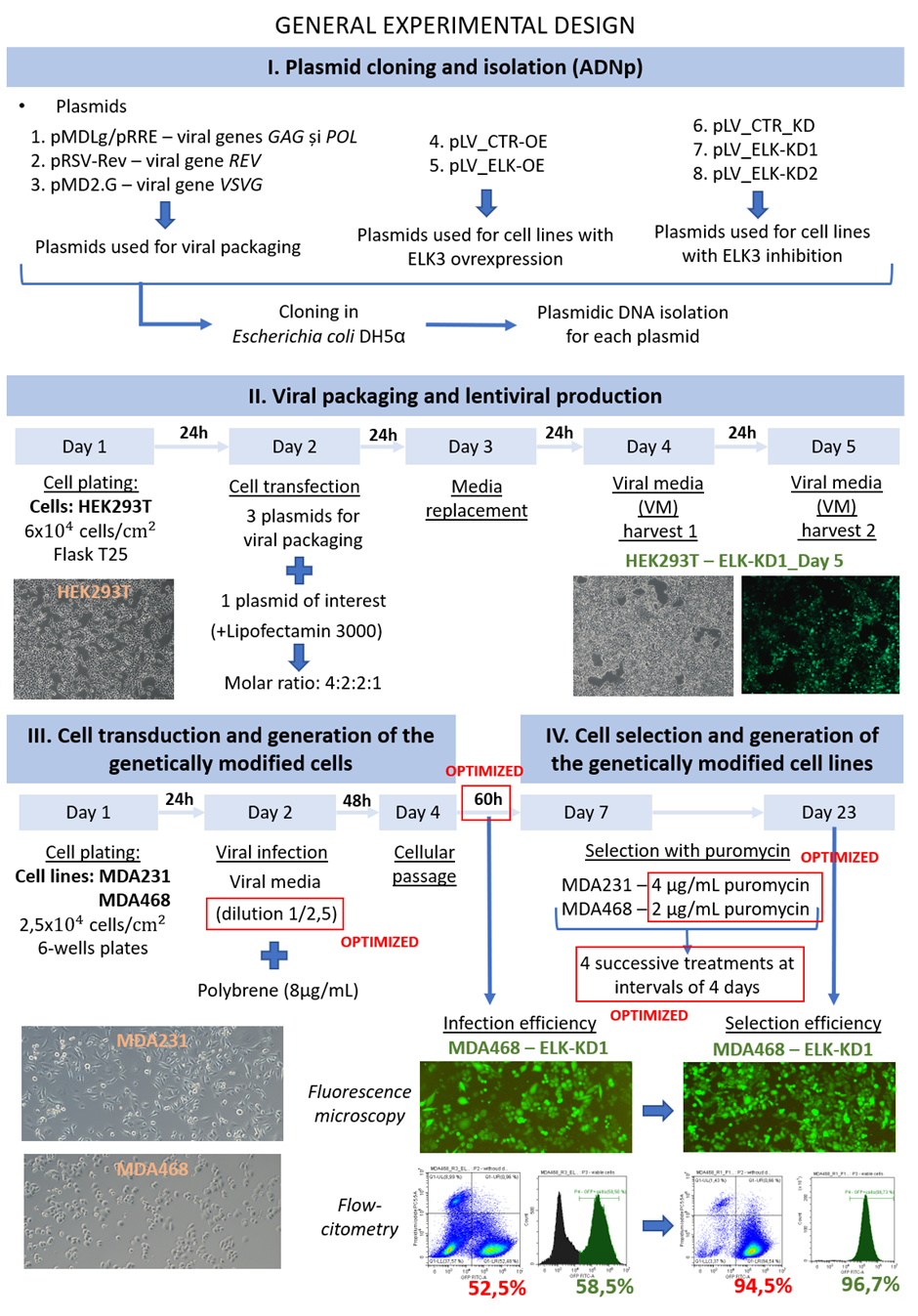 Fig. 1 The general experimental design used to obtain the genetically modified MDA231 and MDA468 cell lines, in which the transcription factor ELK3 in up-/down-regulated. The efficiency of both infection and selection were assessed by fluorescence microscopy and flow cytometry. All experiments were implemented in 3 biological replicates. The details of the experimental protocol that were optimized during the implementation of this project are highlighted by red callouts next to the word "OPTIMIZED".
Fig. 1 The general experimental design used to obtain the genetically modified MDA231 and MDA468 cell lines, in which the transcription factor ELK3 in up-/down-regulated. The efficiency of both infection and selection were assessed by fluorescence microscopy and flow cytometry. All experiments were implemented in 3 biological replicates. The details of the experimental protocol that were optimized during the implementation of this project are highlighted by red callouts next to the word "OPTIMIZED".
Therefore, following the implementation of all the activities within this stage, 9 genetically modified breast cancer cell lines were obtained (in 4biological replicates each) in which over 90% of the cells expressed the GFP gene, the reporter gene included in the genetic constructs. The obtained cell lines are:
1. MDA231_ELK-OE – cell line with ELK3 overexpression
2. MDA231_ELK-KD1 - cell line with ELK3 inhibition
3. MDA231_ELK-KD2 - cell line with ELK3 inhibition
4. MDA468_ELK-KD1 - cell line with ELK3 inhibition
5. MDA468_ELK-KD2 - cell line with ELK3 inhibition
+4 genetically modified control cell lines
Morphological aspects and GFP expression among all these cell lines at the end of stage 1 of the project are shown in Figure 2. The number of viable, genetically modified cells for each cell line, for each biological replicate, is shown in Table 1.
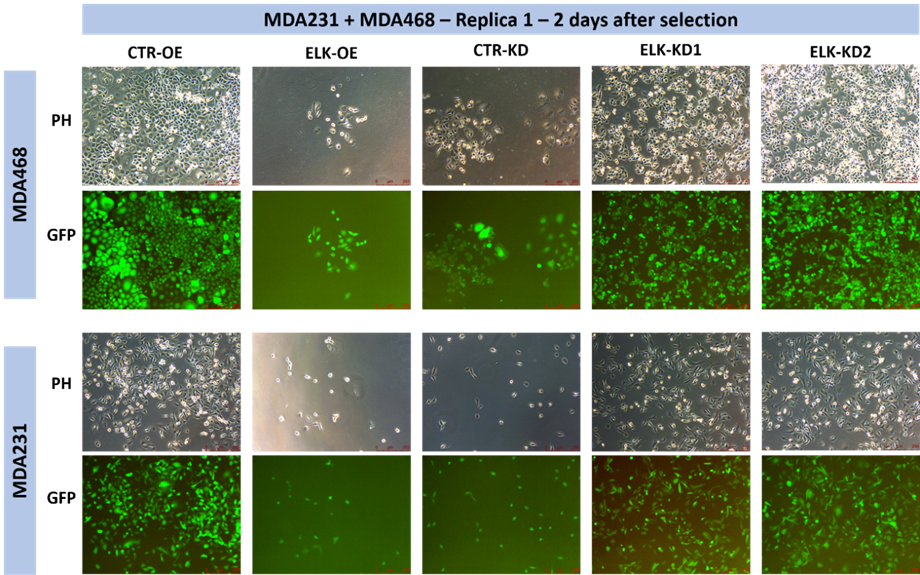 Fig. 2 Morphological aspects and GFP expression among the 10 genetically modified cell lines by lentiviral transduction (biological replica 1), two days after cessation of selection: cell cultures under phase contrast (PH) and UV light (GFP) (DMi8, Leica - 10X objective).
Fig. 2 Morphological aspects and GFP expression among the 10 genetically modified cell lines by lentiviral transduction (biological replica 1), two days after cessation of selection: cell cultures under phase contrast (PH) and UV light (GFP) (DMi8, Leica - 10X objective).
Table 2. Number of viable, genetically modified (GFP+) cells with each genetic construct of interest for each cell line and biological replica, available in liquid nitrogen-stored cryotubes.
The stable transformation of the cell lines was assessed by PCR (testing the transgenes integration in the genome), RT-qPCR (testing the expression levels of ELK3 at the RNA level) and WesternBlot (testing the expression levels of ELK3 al the protein level) (Fig. 3).
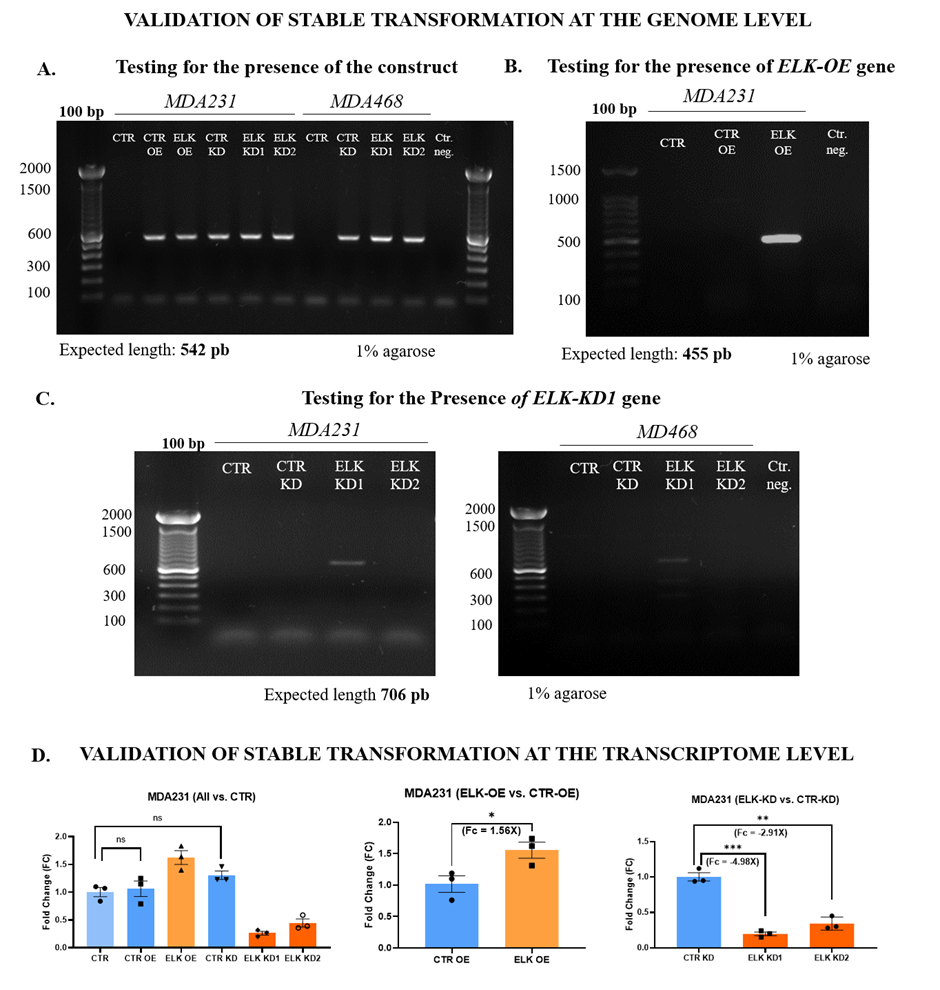 Fig. 3 Validation of the stable transformation of MDA231 and MDA468 cell lines at the genome level by PCR with specific primers for the constructs used in the transformation (A), for the coding sequence of the ELK3 gene without introns (B) and for the shRNA specific sequence found in the ELK-KD1 construct (C) and at the transcriptome level by RT-qPCR , with primers specific for the ELK3 gene (D).
Fig. 3 Validation of the stable transformation of MDA231 and MDA468 cell lines at the genome level by PCR with specific primers for the constructs used in the transformation (A), for the coding sequence of the ELK3 gene without introns (B) and for the shRNA specific sequence found in the ELK-KD1 construct (C) and at the transcriptome level by RT-qPCR , with primers specific for the ELK3 gene (D).
In order to achieve this objective, in a first phase, the general experimental design of lentiviral transduction (Fig. 1) and the design of genetic constructs inserted into plasmids (Activity 1.1) were created. Subsequently, lentiviral-mediated genetic modification (Activity 1.2) was implemented by: 1. cloning the plasmids (containing the gene constructs) into bacteria and further isolating them, 2. viral packaging with the plasmids of interest by cell transfection into the HEK293T cell line and harvesting the lentivirus, 3. transducing breast cancer target cells by their infection with the previously obtained lentivirus and 4. the selection of genetically modified cells based on the marker gene included in the construct. These cells, which were possibly genetically modified, were characterized in terms of their viability on the one hand (labeling with propidium iodide PI), and in term of GFP expression (a reporter gene inserted into the genetic constructs) on the other hand, by fluorescence microscopy and flow cytometry. The success of the genetic modification of these cell lines (Activity 1.3) is also to be investigated by PCR (testing for the presence of the sequences of interest in the target cells’ genome), RT-qPCR (evaluation of ELK3 expression at the mRNA level) and WesternBlot (evaluation of ELK3 expression at the protein level).
The viral packaging system used to obtain the virus was a third-generation one, the actual genetic modification being based, like all lentiviral transduction systems, on the ability of the human immunodeficiency virus (HIV-1) to insert foreign genetic material into the genome of cells. The third generation systems use only 4 genes from the HIV genome (in addition to the gene of interest): GAG, POL, REV and a gene for viral capsid proteins, which represent the minimum genetic information required for viral packaging and subsequent transduction. At the same time, the 4 genes are distributed in 3 different plasmids, and the expression of viral particles in the process of viral packaging is conditioned by molecular elements present only in virus-producing cells (HEK293T in this experimental design). All this increases the level of biosafety in experiments where the lentivirus is used.
 Fig. 1 The general experimental design used to obtain the genetically modified MDA231 and MDA468 cell lines, in which the transcription factor ELK3 in up-/down-regulated. The efficiency of both infection and selection were assessed by fluorescence microscopy and flow cytometry. All experiments were implemented in 3 biological replicates. The details of the experimental protocol that were optimized during the implementation of this project are highlighted by red callouts next to the word "OPTIMIZED".
Fig. 1 The general experimental design used to obtain the genetically modified MDA231 and MDA468 cell lines, in which the transcription factor ELK3 in up-/down-regulated. The efficiency of both infection and selection were assessed by fluorescence microscopy and flow cytometry. All experiments were implemented in 3 biological replicates. The details of the experimental protocol that were optimized during the implementation of this project are highlighted by red callouts next to the word "OPTIMIZED".Therefore, following the implementation of all the activities within this stage, 9 genetically modified breast cancer cell lines were obtained (in 4biological replicates each) in which over 90% of the cells expressed the GFP gene, the reporter gene included in the genetic constructs. The obtained cell lines are:
1. MDA231_ELK-OE – cell line with ELK3 overexpression
2. MDA231_ELK-KD1 - cell line with ELK3 inhibition
3. MDA231_ELK-KD2 - cell line with ELK3 inhibition
4. MDA468_ELK-KD1 - cell line with ELK3 inhibition
5. MDA468_ELK-KD2 - cell line with ELK3 inhibition
+4 genetically modified control cell lines
Morphological aspects and GFP expression among all these cell lines at the end of stage 1 of the project are shown in Figure 2. The number of viable, genetically modified cells for each cell line, for each biological replicate, is shown in Table 1.
 Fig. 2 Morphological aspects and GFP expression among the 10 genetically modified cell lines by lentiviral transduction (biological replica 1), two days after cessation of selection: cell cultures under phase contrast (PH) and UV light (GFP) (DMi8, Leica - 10X objective).
Fig. 2 Morphological aspects and GFP expression among the 10 genetically modified cell lines by lentiviral transduction (biological replica 1), two days after cessation of selection: cell cultures under phase contrast (PH) and UV light (GFP) (DMi8, Leica - 10X objective).Table 2. Number of viable, genetically modified (GFP+) cells with each genetic construct of interest for each cell line and biological replica, available in liquid nitrogen-stored cryotubes.
| Genetic construct | Replica 1 | Replica 2 | Replica 3 | |||
| MDA468 | MDA231 | MDA468 | MDA231 | MDA468 | MDA231 | |
| CTR OE | 171.733 | 424.742 | 993.200 | 532.062 | 570.143 | 28.485 |
| ELK OE | 0 | 61.357 | 0 | 80.448 | 0 | 76.820 |
| CTR KD | 355.421 | 982.096 | 154.460 | 744.595 | 0 | 1.164.096 |
| ELK KD1 | 623.427 | 371.655 | 699.205 | 526.671 | 538.260 | 517.005 |
| ELK KD2 | 1.213.279 | 474.198 | 515.393 | 684.875 | 451.051 | 430.711 |
The stable transformation of the cell lines was assessed by PCR (testing the transgenes integration in the genome), RT-qPCR (testing the expression levels of ELK3 at the RNA level) and WesternBlot (testing the expression levels of ELK3 al the protein level) (Fig. 3).
 Fig. 3 Validation of the stable transformation of MDA231 and MDA468 cell lines at the genome level by PCR with specific primers for the constructs used in the transformation (A), for the coding sequence of the ELK3 gene without introns (B) and for the shRNA specific sequence found in the ELK-KD1 construct (C) and at the transcriptome level by RT-qPCR , with primers specific for the ELK3 gene (D).
Fig. 3 Validation of the stable transformation of MDA231 and MDA468 cell lines at the genome level by PCR with specific primers for the constructs used in the transformation (A), for the coding sequence of the ELK3 gene without introns (B) and for the shRNA specific sequence found in the ELK-KD1 construct (C) and at the transcriptome level by RT-qPCR , with primers specific for the ELK3 gene (D). STAGE 2_2023
In the second stage of this project we aimed to evaluate the impact of ELK3 transcription factor in 3 interconnected metastasis-related cellular processes: cellular migration, the epithelial-to-mesenchymal transition (EMT) and in acquiring a cancer stem cell (CSC) phenotype, by using the genetically modified cell lines obtained during the first phase of the project.
The migration capacity of all cell lines was evaluated in a microfludic approach, in PDMS microfluidic devices fabricated using the soft lithography technique. These devices consisted in a central well connected with the media around the device through two arrays of 50 parallel channels, each channel being 600 µm long and 10 µm wide (Fig. 4A). The microfludic devices were coated with type IV collagen, to mimic some of the extracellular matrix components. The cell behavior was monitored for 24h and imaged at 10 min intervals with a Nikon microscope equipped with an incubation chamber. The migration capacity was monitored based on 2 parameters: migration speed (average displacement over 10 min time intervals), and migration persistence (net displacement over total distance travelled). Our results show that ELK3 overexpression stimulates the migration capacity of triple-negative breast cancer cell lines, increasing both migration speed (Fig. 4B) and persistence (Fig. 4C).
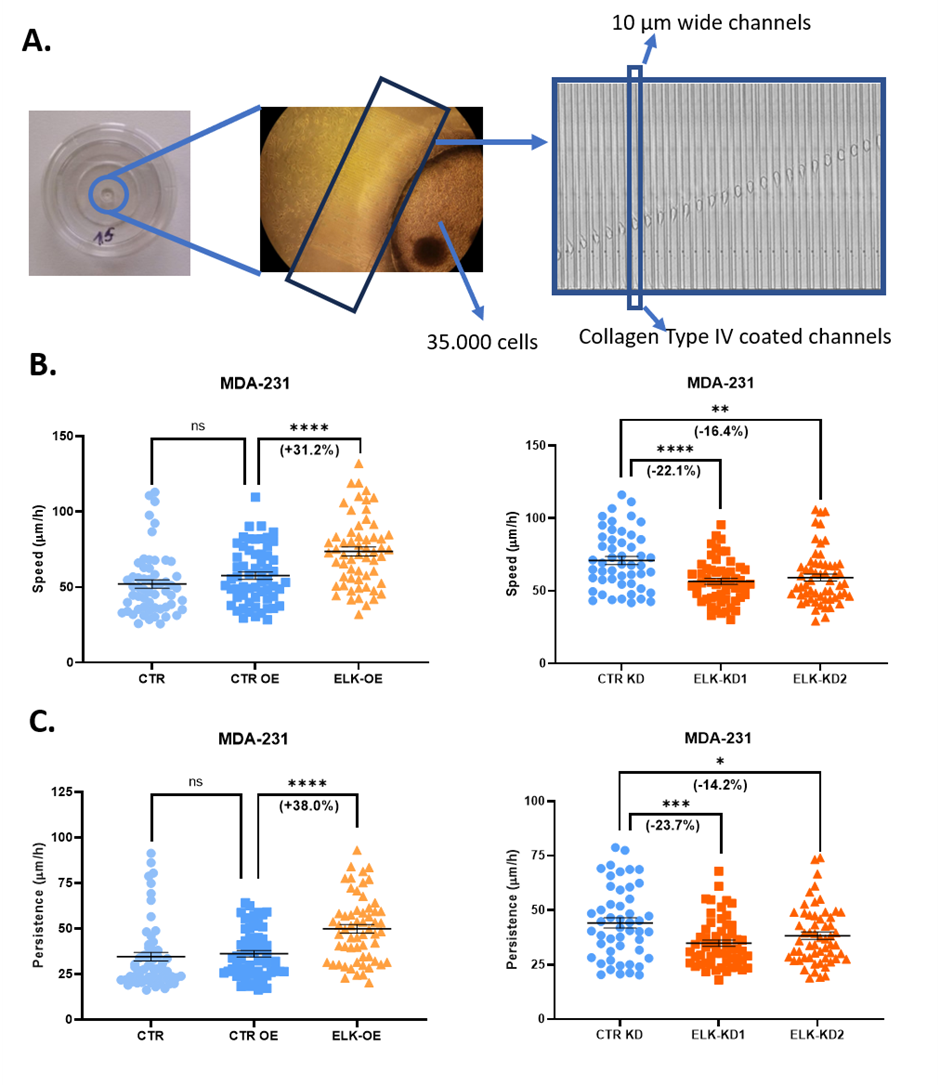 Fig. 1 The cell migration capacity in 3D microfluidic devices (A), in terms of speed (B) and persistence (C), for MDA-231 cells overexpressing ELK3 (ELK-OE) or with inhibited ELK3 expression (ELK-KD1 and ELK-KD2).
Fig. 1 The cell migration capacity in 3D microfluidic devices (A), in terms of speed (B) and persistence (C), for MDA-231 cells overexpressing ELK3 (ELK-OE) or with inhibited ELK3 expression (ELK-KD1 and ELK-KD2).
The phenotype on the epithelial-mesenchymal continuum was assessed by flow-cytometry, both before and after ELK3 overexpression and knockdown. In this assay, specific markers for either the epithelial or mesenchymal phenotypes, mainly E-cadherin, N-cadherin, and pancytokeratin, were used in order to differentiate the two phenotypes and the cell subpopulations. These experiments were performed S3e Cell Sorter (BioRad). Epithelial markers were found increased in cells characterized by ELK3 knockdown (E-cadherin in MDA468_ELK_KD1 and MDA468_ELK_KD1; Pancytokeratin in MDA231_ELK_KD1 and MDA231_ELK_KD2), suggesting the ELK3 involvement in triggering EMT in triple-negative breast cancer cells.
The stemness potential of all cell lines, both parental and transformed, was assessed by a mammosphere formation assay. This assay is widely used for its ability to retrospectively identify sphere-forming cells that develop from single stem cell-like clones, allowing the estimation of the sphere forming efficiency (SFE) 38. After cultivating a small number of cells in a mammosphere induction media for 14 days, the stemness potential of each cell line was evaluated based on the average diameter and number of spheroids formed (cell conglomerates with diameters grater then 50 µm or 60 µm). Our results showed that ELK3 overexpression increases the stem capacity of MDA-231 cells, the ELK-OE cell line forming significantly more and larger spheroids then control cells (Fig. 2)
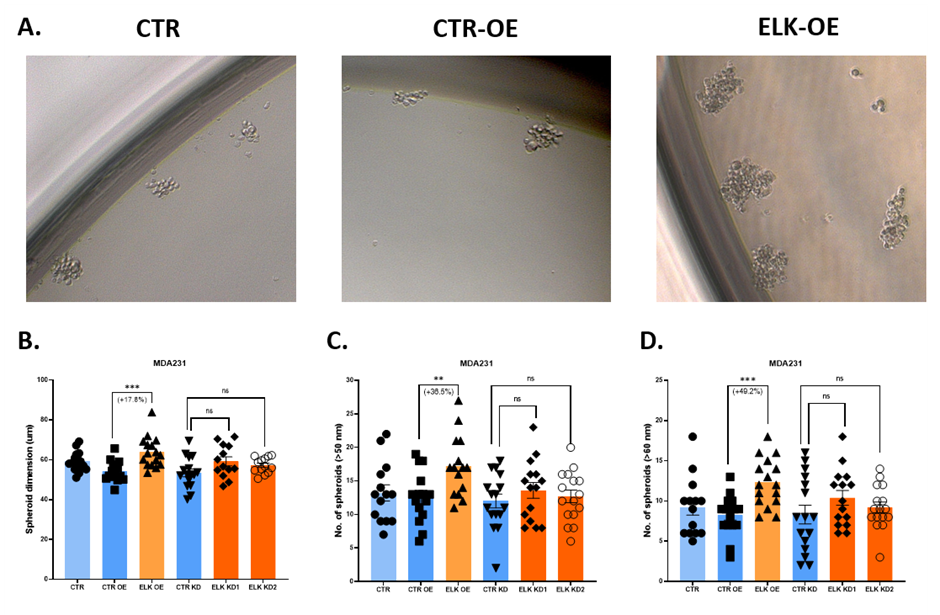 Fig. 2 The stemness potential of MDA-231 cells overexpressing ELK3 (ELK-OE) or with inhibited ELK3 expression (ELK-KD1 and ELK-KD2) in mammosphere formation assays (A), based on the dimensions (B) and number (C and D) of spheroids formed.
Fig. 2 The stemness potential of MDA-231 cells overexpressing ELK3 (ELK-OE) or with inhibited ELK3 expression (ELK-KD1 and ELK-KD2) in mammosphere formation assays (A), based on the dimensions (B) and number (C and D) of spheroids formed.
The migration capacity of all cell lines was evaluated in a microfludic approach, in PDMS microfluidic devices fabricated using the soft lithography technique. These devices consisted in a central well connected with the media around the device through two arrays of 50 parallel channels, each channel being 600 µm long and 10 µm wide (Fig. 4A). The microfludic devices were coated with type IV collagen, to mimic some of the extracellular matrix components. The cell behavior was monitored for 24h and imaged at 10 min intervals with a Nikon microscope equipped with an incubation chamber. The migration capacity was monitored based on 2 parameters: migration speed (average displacement over 10 min time intervals), and migration persistence (net displacement over total distance travelled). Our results show that ELK3 overexpression stimulates the migration capacity of triple-negative breast cancer cell lines, increasing both migration speed (Fig. 4B) and persistence (Fig. 4C).
 Fig. 1 The cell migration capacity in 3D microfluidic devices (A), in terms of speed (B) and persistence (C), for MDA-231 cells overexpressing ELK3 (ELK-OE) or with inhibited ELK3 expression (ELK-KD1 and ELK-KD2).
Fig. 1 The cell migration capacity in 3D microfluidic devices (A), in terms of speed (B) and persistence (C), for MDA-231 cells overexpressing ELK3 (ELK-OE) or with inhibited ELK3 expression (ELK-KD1 and ELK-KD2).The phenotype on the epithelial-mesenchymal continuum was assessed by flow-cytometry, both before and after ELK3 overexpression and knockdown. In this assay, specific markers for either the epithelial or mesenchymal phenotypes, mainly E-cadherin, N-cadherin, and pancytokeratin, were used in order to differentiate the two phenotypes and the cell subpopulations. These experiments were performed S3e Cell Sorter (BioRad). Epithelial markers were found increased in cells characterized by ELK3 knockdown (E-cadherin in MDA468_ELK_KD1 and MDA468_ELK_KD1; Pancytokeratin in MDA231_ELK_KD1 and MDA231_ELK_KD2), suggesting the ELK3 involvement in triggering EMT in triple-negative breast cancer cells.
The stemness potential of all cell lines, both parental and transformed, was assessed by a mammosphere formation assay. This assay is widely used for its ability to retrospectively identify sphere-forming cells that develop from single stem cell-like clones, allowing the estimation of the sphere forming efficiency (SFE) 38. After cultivating a small number of cells in a mammosphere induction media for 14 days, the stemness potential of each cell line was evaluated based on the average diameter and number of spheroids formed (cell conglomerates with diameters grater then 50 µm or 60 µm). Our results showed that ELK3 overexpression increases the stem capacity of MDA-231 cells, the ELK-OE cell line forming significantly more and larger spheroids then control cells (Fig. 2)
 Fig. 2 The stemness potential of MDA-231 cells overexpressing ELK3 (ELK-OE) or with inhibited ELK3 expression (ELK-KD1 and ELK-KD2) in mammosphere formation assays (A), based on the dimensions (B) and number (C and D) of spheroids formed.
Fig. 2 The stemness potential of MDA-231 cells overexpressing ELK3 (ELK-OE) or with inhibited ELK3 expression (ELK-KD1 and ELK-KD2) in mammosphere formation assays (A), based on the dimensions (B) and number (C and D) of spheroids formed. STAGE 3_2024
In the third phase of the project, we aimed to identify the modifications in the gene expression patterns triggered by ELK3 overexpression and knockdown, in a genomic approach, in order to determine the main molecular mechanisms by which this transcription factor affects TNBC metastasis. The rationale behind this objective is to group the genes that are modulated by ELK3 into signaling pathways associated with BC metastasis, by overlapping the results obtained for ELK3 overexpression with the ones obtained for ELK3 knock down.
We evaluated the expression level for all the genes in the human genome by a holistic functional genomic approach, using the microarray technology, starting with the total RNA extracted from one of the cell lines in which the ELK3 transcription factor is down-regulated. The expression levels of some of the genes from the microarray data were also validated by RT-qPCR in both transformed (ELK-OE and ELK-KD) and parental cell lines.
In the microarray analysis of MDA231_ELK-KD1 vs. MDA231_CTR-KD, we identified 740 genes modulated by the inhibition of the ELK3 transcription factor (FR > ±1.3, p<0.05), of which 322 were overexpressed and 418 were downregulated. The top 50 upregulated and downregulated genes based on the microarray data, plotted for each biological replicate, are shown in Figure 1.
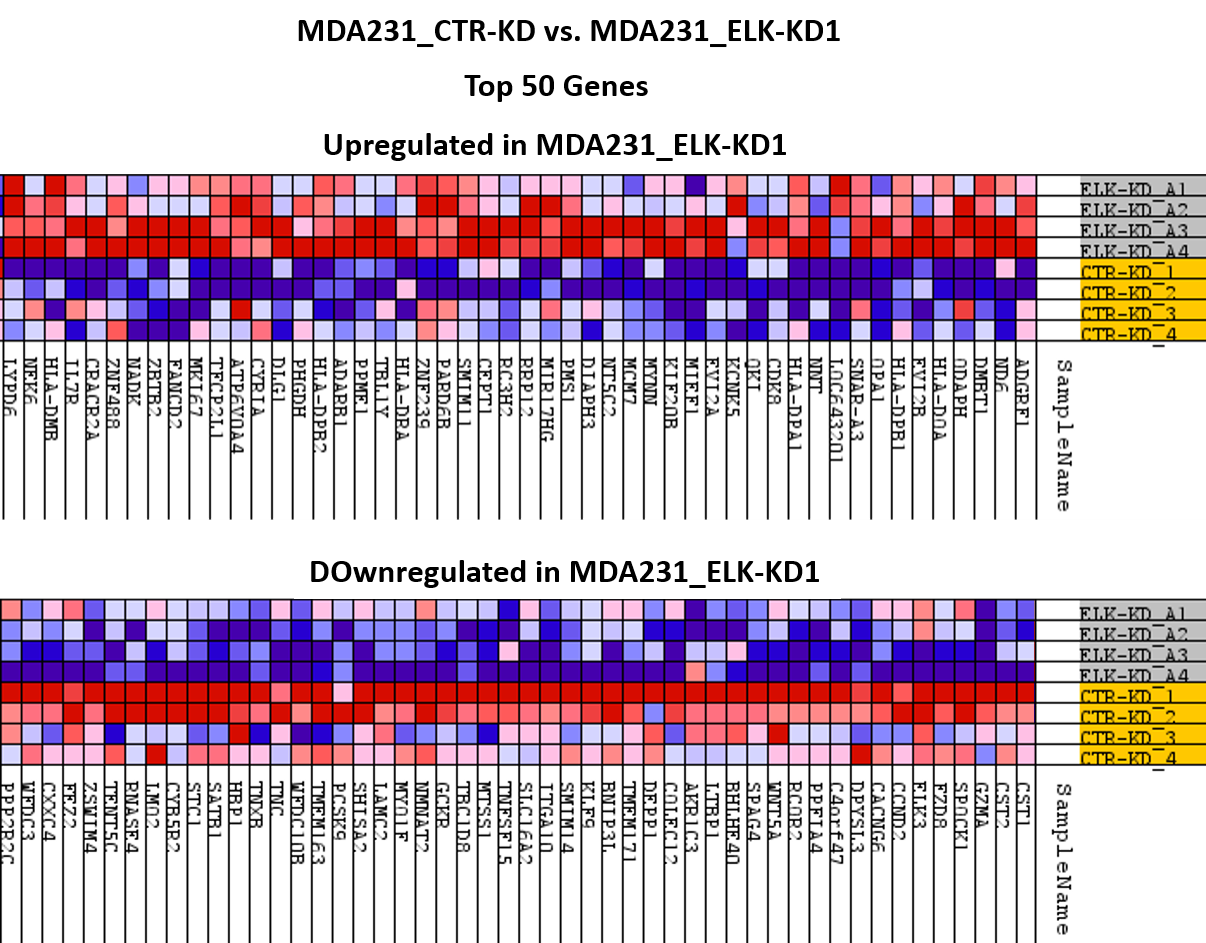 Fig. 1 Top 50 upregulated and dowregulated genes following ELK3 inhibition (MDA231_ELK-KD1 vs. MDA231_CTR-KD), based on microarray data, represented for each biological replica (images created in GSEA_4.3.0 software).
Fig. 1 Top 50 upregulated and dowregulated genes following ELK3 inhibition (MDA231_ELK-KD1 vs. MDA231_CTR-KD), based on microarray data, represented for each biological replica (images created in GSEA_4.3.0 software).
The whole set of differentially expressed genes (n=740) obtained in the microarray analysis were used for the functional analysis in Ingenuity Pathway Analysis Software (IPA). Functional analysis in the IPA software revealed 43 cellular processes affected by ELK3 transcription factor inhibition, 22 of which are related to cancer. The main cellular processes triggered by the inhibition of the ELK3 transcription factor were the inhibition of cell invasion and migration and the inhibition of the self-renewal capacity of cells, doubled by the induction of apoptosis, with the impairment of cell viability, demonstrating, on the molecular level, the cellular processes induced by ELK3 in our cell lines. Therefore, we are now able to present the main molecular mechanisms by which ELK3 impacts TNBC metastasis in terms of cell motility and and stemness potential.
We evaluated the expression level for all the genes in the human genome by a holistic functional genomic approach, using the microarray technology, starting with the total RNA extracted from one of the cell lines in which the ELK3 transcription factor is down-regulated. The expression levels of some of the genes from the microarray data were also validated by RT-qPCR in both transformed (ELK-OE and ELK-KD) and parental cell lines.
In the microarray analysis of MDA231_ELK-KD1 vs. MDA231_CTR-KD, we identified 740 genes modulated by the inhibition of the ELK3 transcription factor (FR > ±1.3, p<0.05), of which 322 were overexpressed and 418 were downregulated. The top 50 upregulated and downregulated genes based on the microarray data, plotted for each biological replicate, are shown in Figure 1.
 Fig. 1 Top 50 upregulated and dowregulated genes following ELK3 inhibition (MDA231_ELK-KD1 vs. MDA231_CTR-KD), based on microarray data, represented for each biological replica (images created in GSEA_4.3.0 software).
Fig. 1 Top 50 upregulated and dowregulated genes following ELK3 inhibition (MDA231_ELK-KD1 vs. MDA231_CTR-KD), based on microarray data, represented for each biological replica (images created in GSEA_4.3.0 software).The whole set of differentially expressed genes (n=740) obtained in the microarray analysis were used for the functional analysis in Ingenuity Pathway Analysis Software (IPA). Functional analysis in the IPA software revealed 43 cellular processes affected by ELK3 transcription factor inhibition, 22 of which are related to cancer. The main cellular processes triggered by the inhibition of the ELK3 transcription factor were the inhibition of cell invasion and migration and the inhibition of the self-renewal capacity of cells, doubled by the induction of apoptosis, with the impairment of cell viability, demonstrating, on the molecular level, the cellular processes induced by ELK3 in our cell lines. Therefore, we are now able to present the main molecular mechanisms by which ELK3 impacts TNBC metastasis in terms of cell motility and and stemness potential.
TEAM
Project director: Lect. Cruceriu Daniel, PhD
Mentor: Prof. Banciu Manuela, PhD
Mentor: Prof. Banciu Manuela, PhD
Contact
- 5-7 Clinicilor Street, Cluj, Cluj - Napoca, România
